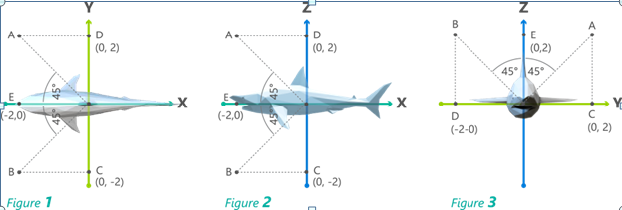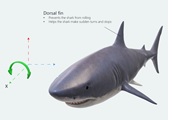Move Like a Shark
Inquiry-based STEM activity from Microsoft Education and BBC Learning’s How Do Sharks Swim? It can be done separately or in a sequence with Build a Joystick to Control Shark Movement activity. Click HERE for PDF of the activity.
Summary
Middle school students take on the role of marine biologists to investigate how sharks move in three-dimensional space (3-D). Understanding the mathematics behind shark movement will inform the design of a prototype joystick for a robotic exploration shark used to collect oceanic data.
Grade level: 6-8
Time: 75 minutes
Learning objectives
After doing this activity, students should be able to:
- Use analog and digital models to describe rotational movement on the z, y, and x axes.
- Describe the structures of a shark’s anatomy that help it change direction as it swims using digital 3-D models.
Learning standards
Next Generation Science Standards
- MS-ETS1-4: Develop a model to generate data for iterative testing and modification of a proposed object, tool, or process such that an optimal design can be achieved.
- MS-LS3-1: Complex and microscopic structures and systems can be visualized, modeled, and used to describe how their function depends on the shapes, composition, and relationships among its parts, therefore complex natural structures/systems can be analyzed to determine how they function.
Common Core State Mathematics Standards
- CCSS.Math.Content.8.G.A.3: describe the effect of dilations, translations, rotations, and reflections on two-dimensional figures using coordinates.
ISTE
- 3a: Students plan and employ effective research strategies to locate information and other resources for their intellectual or creative pursuits.
- 5b: Students collect data or identify relevant data sets, use digital tools to analyze them, and represent data in various ways to facilitate problem-solving and decision-making.
- 7c: Students contribute to project teams, assuming various roles and responsibilities to work effectively toward a common goal.
Introduction
In this lesson, students will learn about three-dimensional space and how sharks move within it, remaining balanced as they swim and turn. Students will explore how sharks change direction using rotations on the z, y, and x axes (yaw, pitch, and roll), and connect shark anatomy to these movements. This lesson can be applied to instruction on aeronautics and aerospace engineering.
Engineering connection/motivation
Engineers use robotic fish to collect data in aquatic ecosystems. Their designs mimic the elegant physical structures of fish that allow them to move within their three-dimensional environments. These movements are related to the mathematics of rotations on the z, y, and x axes. These rotations, known as yaw, pitch, and roll, are the same type of movements that must be considered by aeronautical engineers when they design airplanes.
Materials
For each student:
- 1 8×8 cm piece of cardboard
- 3 bamboo skewers
- 1 biodegradable straw
- 1 wooden spool
- 3 pictures of sharks
Note: Download individual elements of the lesson as you go through the Science and engineering notebook or download all assets for understand shark movement.
Procedure
Before the activity:
- For footage of wondrous Oceans, view the BBC Earth & OceanX Film Oceans: Our Blue Planet trailer.
- Familiarize yourself with instructions and tech requirements before teaching to mitigate unforeseen challenges.
- Download the free Data Streamer add-in for Excel to support real-time data streaming.
- Confirm students have access to all links. Download PowerPoint resources.
- Confirm that each student computer has all required software:
• Office 365
• Microsoft Excel 2016 (desktop version) with Office 365 subscription
• Microsoft PowerPoint 2016 (desktop version) with Office 365 subscription
• Windows 10 Fall Creators Update
Introduce the design challenge
Welcome young scientists and engineers! You have been invited to participate in an important science and engineering project!
A multinational technology corporation is funding an effort to explore and research some of Earth’s last unexplored regions: our oceans! Engineers from the corporation have developed a robotic shark that can be deployed from research submarines. The shark will be used to collect data on ocean pollution and study marine organisms in their habitat. Project leaders have asked you and your team of marine biologists to explore the three-dimensional movement of sharks. This knowledge will prepare you for testing a prototype joystick to control a robotic shark.
Investigate how sharks move in three-dimensional space (3-D) to inform the design of a prototype joystick for a robotic exploration shark.
Your contribution has the potential to positively impact the health of aquatic ecosystems and unlock secrets that lie beneath the ocean surface.
Good luck!
Activity
Have students refer to the science and engineering notebook.
Build the Rotation on an axis model using the instructions.
1 | Describe the rotation of your shark on the x-axis. How would this type of movement help a shark as it moves through the water?
2 | Describe the rotation of your shark on the y-axis. How would this type of movement help a shark as it moves through the water?
3 | Describe the rotation of your shark on the z-axis. How would this type of movement help a shark as it moves through the water?

Use the three-axis rotation diagrams in Figures 1-3 and your Rotation on an axis model to answer the following questions:
4 | Which figure represents roll?
5 | What are the coordinates of points A and B in the figure that represents roll?
6 | Which figure represents pitch?
7 | What are the coordinates of points A and B in the figure that represents pitch?
Use Excel to understand 2-D and 3-D space using the Mathematical modeling of rotation workbook to see how rotation on the x and y axes changes the coordinates of a polygon.
1 | How is the rotation of points A, B, or C on the triangle in the Polygon Rotation sheet similar or different to points A and B on the 3-axis rotation figures?
2 | In Excel, extend your understanding of rotation to 3-dimensions by studying how a 3-dimensional pyramid rotates on the z, y, and x axes in the 3-axis rotation sheet.
Yaw, pitch, and roll 
Use the Shark anatomy and movement PowerPoint to research and answer the following questions:
1 | What are yaw, pitch, and roll? Which axes rotations relate to yaw, pitch, and roll of a shark?
2 | What other types of things exhibit yaw, pitch, and roll movements?
3 | Bring your shark to life by using Paint 3D and importing models into PowerPoint to paint shark anatomy that control yaw, pitch, and roll.
- Import your shark model into PowerPoint.
- Label the parts that are used for yaw, pitch, and roll.
- Animate the model to demonstrate yaw, pitch, and roll rotations.
Self-guided real-world exploration
1 | Visit Exploring a shark in mixed reality to engage in a self-guided exploration of the shark’s anatomy and movement in the real world.
Reflection questions
Use the How to create a video reflection tutorial to discover how to use Microsoft Photos to reflect on your learning. See an example of how to combine photos and videos. Use these questions to guide you in creating a reflection:
1 | How is a shark’s anatomy related to how it changes direction and stays balanced?
2 | Sketch an initial plan for a controller that would direct a robotic shark’s movement in yaw, pitch, and roll.
3 | What would you like to investigate further about shark movement?
Filed under: Class Activities, Grades 6-8, Lesson Plans
Tags: 3-D motion, Aeronautics, Cartesian coordinates, Class Activities, drag, forces, Grades 6-8, Lesson Plan, programming, shark movement, speed, x, y, z axes








